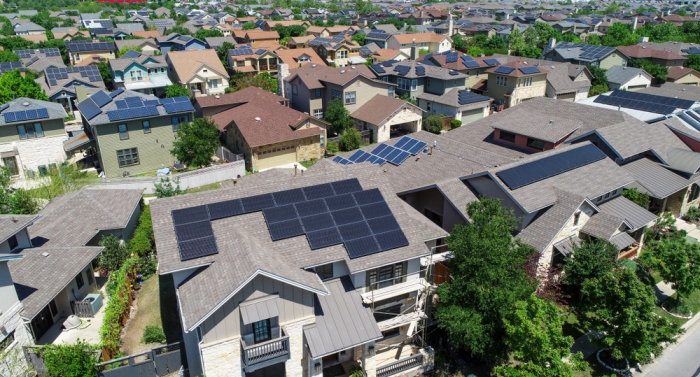A tecnologia solar gira em torno de painéis fotovoltaicos (PV), que são marcas tecnológicas notáveis que convertem a luz solar em eletricidade.
Enquanto navegamos nos meandros da transição para fontes de energia renovável, permanece uma questão fundamental: quanta energia um painel solar produz?
Estamos aqui para fornecer um guia completo para ajudá -lo a entender os vários fatores que afetam a produção de energia solar e responde a perguntas comuns.
A partir da localização da sua instalação solar ao tamanho e eficiência dos painéis, abordaremos os aspectos científicos e práticos da energia solar. saída de saída? Embora os painéis tenham um desempenho mais eficiente em climas mais ensolarados devido ao aumento da exposição à luz solar, é um equívoco comum que as temperaturas mais quentes aumentem a produção. Na realidade, os painéis solares operam com mais eficiência em condições mais frias, apesar de exigir luz solar abundante, pois o calor excessivo pode reduzir sua produtividade. Os painéis de eficiência mais alta geram mais eletricidade mesmo em espaço limitado. Defeitos ou problemas são prontamente capturados e endereçados para manter a saída ideal.
Factors Influencing Solar Panel Output
Before we explore the specifics of solar panel energy production, it’s essential to understand the factors that influence output.
What affects solar panel output?
- Shading : Shading from trees, buildings, or other structures can significantly reduce the amount of sunlight that reaches your solar panels , thereby decreasing their output power.
- Climate and Location : Solar panel performance is significantly influenced by geographical location and climate conditions. While panels perform more efficiently in sunnier climates due to increased sunlight exposure, it’s a common misconception that hotter temperatures boost output. In reality, solar panels operate most efficiently in cooler conditions, despite requiring abundant sunlight, as excessive heat can reduce their productivity.
- Panel Efficiency : The efficiency of a solar panel , which is determined by its ability to convert sunlight into electricity, plays a crucial role in how much power it can produce. Higher efficiency panels generate more electricity even in limited space.
- Orientation and Angle: Proper alignment of solar panels towards the sun and the angle at which they are installed can greatly impact their energy production efficiency, with optimal settings maximizing sunlight exposure.
- Monitoring : Regular monitoring of solar panel systems helps identify performance issues early, ensuring any defects or issues are promptly caught and addressed to maintain optimal output.
- Maintenance : Routine maintenance, such as cleaning the panels and removing debris, is essential for sustaining peak performance levels and prolonging the lifespan of solar panels.
What’s the difference between power and energy?
Alright, let’s start at the beginning: A potência é medida em quilowatts (kW), enquanto a energia é medida em quilowatt-hours (kWh). No caso de energia elétrica, um quilowatt representa a quantidade de energia que está sendo consumida ou produzida em um determinado momento. But that’s probably still confusing, so we’ll dig in further.
What’s a kilowatt?
A kilowatt (kW) is a unit of power that equals one thousand watts. In the case of electrical energy, a kilowatt represents the amount of energy that is being consumed or produced at a given moment.
por exemplo, se um dispositivo for classificado a 1 kW, significa que ele usa (ou gera, no caso de painéis solares) 1.000 watts de energia elétrica durante sua operação. kw) sendo usado por uma hora. Ao contrário de um quilowatt, que mede energia ou a taxa de uso de energia, um quilowatt-hora mede a quantidade total de energia usada ao longo do tempo. O quilowatt-hora se aplica aos sistemas de energia solar?
What’s a kilowatt-hour?
A kilowatt-hour (kWh) is a measure of energy that represents the amount of energy equivalent to a constant power of one kilowatt (1 kW) being used for one hour. Unlike a kilowatt, which measures power or the rate of energy use, a kilowatt-hour measures the total amount of energy used over time.
For example, if you have a light bulb with a power rating of 100 watts and you leave it on for 10 hours, it would consume 1 kWh of energy (100 watts * 10 hours = 1,000 watt-hours = 1 kWh).

How do kilowatts and kilowatt-hours apply to solar energy systems?
A capacidade de um sistema solar doméstico é normalmente medida em quilowatts. Este número representa a quantidade máxima de energia que os painéis solares podem gerar sob condições ideais de exposição ao sol.
Por exemplo, um sistema solar de 5 kW pode produzir até 5 quilowatts de energia no desempenho de pico. Ao avaliar o tamanho de um sistema solar para uma casa, a classificação Kilowatt ajuda os proprietários a entender a potencial saída de eletricidade que o sistema pode fornecer para atender às suas necessidades de energia. Nos sistemas de energia solar, o KWH é usado para quantificar a quantidade de eletricidade o sistema produz em períodos específicos, como diariamente ou mensalmente. A partir daí, você pode calcular o tamanho necessário de um sistema de energia solar que atenda às suas necessidades. Esses números são baseados no pico médio de horas solares e condições climáticas da luz solar da sua área. Usaremos os mesmos painéis solares de 430W QCell de antes.
Kilowatt-hours measure the actual amount of electricity generated or consumed over time. In solar power systems, kWh is used to quantify how much electricity the system produces over specific periods, such as daily or monthly.
Calculating Solar Panel Energy Production
To determine how much solar energy you need , you first need to assess your household’s average energy consumption. From there, you can calculate the required size of a solar energy system that would meet your needs.
How do I calculate how much solar I need?
Once you know your average energy consumption, all you need to know is the production ratio for your region of the United States. These numbers are based on your area’s average peak sunlight hours and weather conditions.

For this example, let’s say you use roughly 14,500 kWh per year and live in Las Vegas, Nevada. We’ll use the same 430W Qcell solar panels from before.
O cálculo é:
Uso de eletricidade anual % Taxa de produção Taxa % Wattage do painel solar = # painéis solares que você precisa
14.500 % 1,5 % 430 = 22,5 | Compensar totalmente o uso anual de eletricidade!
So, we’ll round up to 23.
You need 23 solar panels installed to fully offset your annual electricity usage!
Quanta energia um painel solar produz por hora? Para este exemplo, vamos usar um painel 430W QCELL Q.TRON BLK M-G2+. dia?
The amount of energy a single solar panel produces per hour will depend on the wattage of the hardware. For this example, let’s use a 430W Qcell Q.TRON BLK M-G2+ panel.
Since we’re only measuring production for a single hour, this calculation will be done in watt-hours instead of kilowatt-hours.
430 watts x 1 peak sun hour = 430 watt-hours
How much energy does a solar panel produce per day?
Quando calculamos a produção de energia por dia, devemos estimar o número de horários de pico do sol. Digamos que a residência esteja em Nevada, para que possamos assumir 6 horas de pico do sol. Apenas multiplique a produção diária do painel pelo número de dias no mês. Usaremos um mês de 30 dias para este exemplo. Basta fazer a mesma produção diária que encontramos antes e multiplicá-la por 365. Ilumine sua viagem de energia solar.
430 watts x 6 peak sun hours = 2,580 watt-hours / 1,000 = 2.58 kilowatt-hours per day
How much energy does a solar panel produce per month?
Now comes the easy part! Just multiply the daily production of the panel by the number of days in the month. We’ll use a 30-day month for this example.
2.58 kilowatt-hours per day x 30 = 77.4 kilowatt-hours per month
How much energy does a solar panel produce per year?
And finally, we’ll find how much energy our solar panel produces per year. Just take that same daily production we found before and multiply it by 365.
2.58 kilowatt-hours per day x 365 = 941.7 kilowatt-hours per year
Common Questions Answered
In this section, we’ll tackle some of the most frequently asked questions about solar power systems , providing you with answers to help illuminate your solar energy journey.
How many solar hours per day?
The concept of “solar hours per day” refers to the number of hours when the sunlight is strong enough to be effectively converted into electricity by solar panels .
Esta figura pode variar significativamente, dependendo da sua localização, mas normalmente cai cerca de 5-6 horas por dia na maioria dos Estados Unidos. Em média, uma TV LED moderna usa cerca de 30 a 100 watts de energia.
How much electricity does a TV use?
The electricity usage of a television depends on its size, type, and the length of time it’s used. On average, a modern LED TV uses about 30 to 100 watts of power.
Sabendo o consumo de energia de seus aparelhos pode ajudá-lo a estimar o Tamanho do sistema solar você pode precisar. Aplica -se a todos, pois muito depende de suas necessidades específicas e consumo de energia. No entanto, existem algumas diretrizes básicas que você pode seguir.
How many solar batteries are needed to power a house?
Obviously, there’s no cut-and-dry answer to how many solar batteries you’ll need that applies to everyone since so much of it depends on your specific needs and energy consumption. However, there are some basic guidelines you can follow.
For households prioritizing continuity during occasional power outages, a single solar battery might suffice, ensuring that essential functions remain operational.
Optar por 2-3 baterias pode ser uma estratégia econômica, oferecendo capacidade de armazenamento suficiente para preencher a lacuna quando seus painéis solares estiverem adormecidos, como durante a noite ou condições climáticas desfavoráveis.
Indivíduos que visam independência energética completa podem considerar investir em um intervalo de 10 a 12 baterias solares. Essa configuração é mais adequada para aqueles que aspiram a uma existência fora da grade e podem não ser necessários para instalações solares residenciais típicas. Artigos
Learn more about our solar products and get a quote today.






